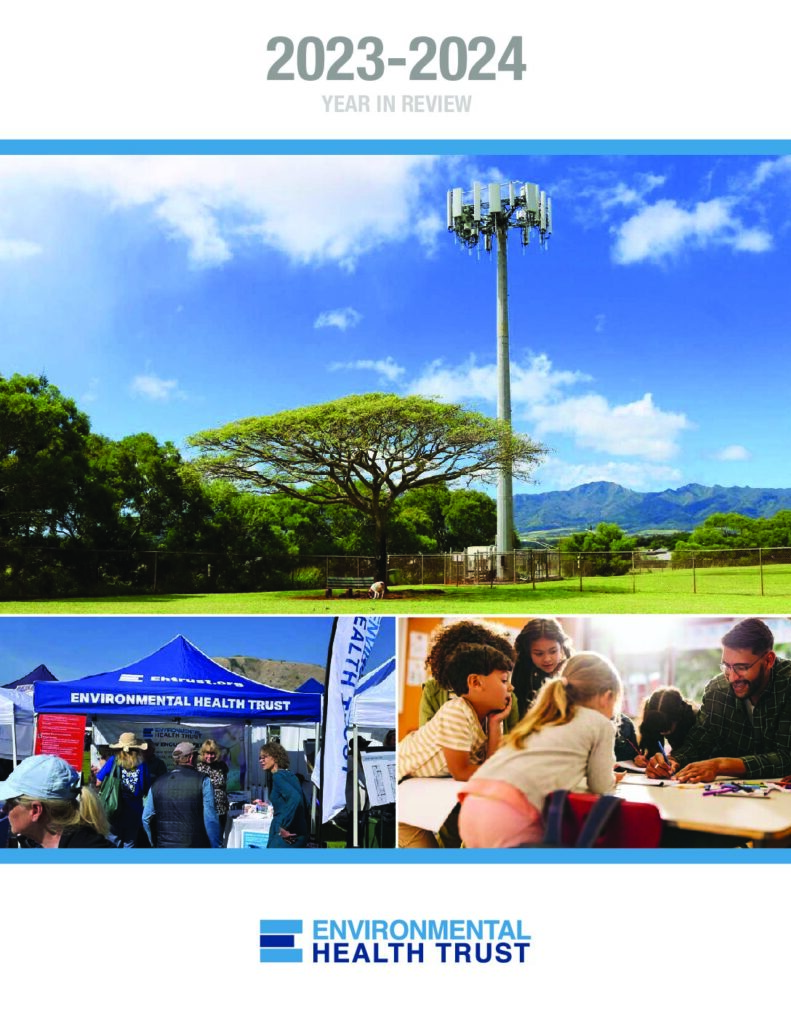Environmental Health Trust has sent a letter to the editor of JAMA Oncology calling for a retraction of an inaccurate review authored by a paid wireless industry spokesperson. Read the first section of the letter here. Download full letter. Download Addendum to the letter.
A Call For Retraction
Letter to Mary L. “Nora” Disis, MD
Editor-in-Chief JAMA Oncology
Cancer Vaccine Institute University of Washington
Dear Dr. Disis:
We are writing to you to call for retraction of the article “Radiofrequency Radiation and Cancer, A Review” by Grimes in the Journal of the American Medical Association Oncology (Grimes, 2021). Although his article purports to be a review article on whether radio frequency radiation (RFR) wireless emissions from cellular phones, wireless electronics, and telecommunications infrastructure can cause cancer, the review inaccurately presents the current state of science, cherry-picks studies, misrepresents study findings, and entirely omits key research studies indicating that cell phone radiation can, and does, cause cancer.
Our scientific understanding of electromagnetic radiation is in a paradigm shift. The ionizing versus non-ionizing model is no longer relevant to understanding the health effects of RFR.
Just because RFR is non-ionizing does not mean that it cannot initiate, promote, or play a role in the development of cancer. Research has found adverse health effects from RFR including increased cancer risk, cellular stress, increase in harmful free radicals, genetic damage, structural and functional changes in the reproductive system, learning and memory deficits, and damage to the nervous system (Belpomme et al., 2018; Miller et., 2019, Schuermann et al., 2021).
Grimes inaccurately states that reviews “do not support claims of genotoxic effects” footnoting an outdated review (Verschaeve, 2005) which is well superseded by the Lai, 2021 review which documents in vitro and in vivo experimental evidence reporting that RFR and non-ionizing electromagnetic radiation can in fact lead to genotoxic effects including DNA strand breaks, micronucleus formation, and chromosomal structural changes.
Experimental studies demonstrating carcinogenicity in animal models caused by RFR are dismissed by in a few sentences. We refer to the studies by the National Toxicology Program (Smith‐Roe et al., 2020; M. Wyde et al., 2018; M. E. Wyde et al., 2018) and by the Ramazzini Institute (Falcioni et al., 2018; Vornoli et al., 2019). Grimes inaccurately refers to the NTP study as only a “preprint” and omits the publications of the findings in a peer-reviewed journal. In addition, following an unprecedented three day peer review, the final NTP reports not only designated the elevated tumors in male rats as “clear evidence” of carcinogenic activity, but in addition, the NTP found significant increases in DNA damage (Smith-Roe et al., 2020), as well as the induction of cardiomyopathy of the right ventricle in male and female rats (NTP, 2018a; 2018b). Analysis of the NTP data according to current risk assessment guidelines concluded that U.S. government FCC limits should be strengthened by 200 to 400 times to protect children (Uche & Naidenko, 2021).
Yet Grimes omits these findings and even omits direct citations to the actual NTP publications in his “review.” Grimes also omits reference to the Ramazzini Institute RFR animal studies which found elevated incidence of the same tumors the NTP found – heart schwannomas in male rats – despite their use of much lower RFR exposures which were intended to mimic cell tower environmental exposures (Falcioni et al., 2018).
Instead of accurately presenting the NTP findings, Grimes dismisses the study because of its “low-power and questionable methods” citing references which themselves have been found by U.S. NIH scientists to be unfounded and unsupported by the study data (Melnick, 2019; 2020, page 83 and 87 Wyde et al., 2018).
Most importantly, Grimes fails to present to JAMA readers how the tumor types found in these two large scale animal studies are the same histological type as tumors found in epidemiological studies of cell phone users (gliomas and acoustic neuromas). This concordance strengthens the animal-to-human association.
Grimes states without reference “nor does any ostensible animal or epidemiological evidence come close to meeting Bradford Hill criteria or similar for causation” but he omits publications which conclude that Bradford Hill criteria is met (Carlberg and Hardell 2017, Peleg et al 2018).
Grimes misleadingly downplays the IARC designation of RFR as a group 2B agent (a possible carcinogen) in 2011 by inaccurately stating that the designation is “misunderstood as implying evidence of harm” and then referencing what he terms a recent “WHO communication.” However, the WHO communication was a chapter – with two pages dedicated to selected RFR studies- co-authored by an ICNIRP member and it was not a systematic review of the recent evidence, nor was it a new determination by IARC. Conflating the two is inaccurate.
Further, Grimes omits that the WHO/IARC advisory group recommended RFR be re-evaluated as “high priority” within 5 years due – largely in part- to the recent animal research findings positive for cancer (IARC, 2019). IARC has not reviewed the research since 2011.
Importantly, the IARC designation in 2011 was based on evidence from the Interphone and Hardell epidemiological studies which Grimes also misrepresented. In the section on epidemiological evidence Grimes inaccurately states that “aside from these large studies” the one exception is Hardell et al., 2011. Grimes inaccurately presented the Interphone study as showing no effects. He also inaccurately referenced the CERENAT study (his footnote 13) as a no effect study when in fact both found increased risks in heaviest long term users (Cardis et al., 2011; Coureau 2014; IARC 2013; Interphone study group, 2010; Turner et al., 2016).
Grimes criticizes the findings from the case-control studies because “researchers note the potential for participant bias and unavoidable recall error.” However, he forgot to mention the reanalysis of the Canadian data (Momoli et al., 2017) that was part of the Interphone study that showed there was no effect on the risk of glioma after adjustments were made for selection and recall bias. The OR of 2.2 was significantly increased in the highest quartile compared to those who were not regular users.
Grimes also omitted more recent research finding RFR associated with thyroid cancer and breast cancer (Luo et al., 2020, Di Ciaula et al., 2021, Carlberg et al., 2020, Shih et al., 2020, West et al., 2013).
Contrary to Grimes’ presentation, the experimental evidence for carcinogenicity has significantly increased since 2011 when the International Agency for Research on Cancer designated wireless RFR as a Class 2B “possible” carcinogen. Thus, several published reviews and expert reports now conclude that the latest data supports an updated conclusion- RFR should be designated as at least a probable carcinogen and even a proven Group 1 human carcinogen (Belpomme et al., 2018; Carlberg and Hardell, 2017; Directorate-General for Parliamentary Research Services (European Parliament) & Belpoggi, 2021; Lin, 2019; Miller et al., 2018; Melnick, 2019; Peleg et al., 2018; Portier 2021).
Grimes misrepresents the stance of the World Health Organization by conflating the WHO EMF Project with the WHO International Agency for Research on Cancer (IARC), two very distinct entities under the umbrella of the WHO. Grimes misleadingly quotes the WHO EMF Project statement that, “no adverse health effects have been established as being caused by mobile phone use” (WHO, 2014). JAMA readers will likely be misled that this WHO statement is an official WHO conclusion substantiated by a science-based research review. However, the fact is that the WHO EMF Project, which penned this 2014 webpage, has not undertaken a research review or a health risk assessment on RFR since 1993 (Electromagnetic Fields (EHC 137, 1992), 1993; Health Risk Assessment, n.d.). Grimes also did not mention the long standing industry ties, transparency issues, and conflicts of interest of the WHO EMF Project (Hardell, 2017) nor did he clarify the difference between the two distinct entities.
While commenting on trends for central nervous system cancers to support his claim of no increased incidence, Grimes referenced an outdated 2010 study that only looked at trends 1992–2006. Grimes ignored the study by Philips et al., 2018 that reported a doubling in incidence of glioblastoma (frontal and temporal lobes) in England between 1995 and 2015.
Several pathways have been suggested to explain how non-ionizing RFR could lead to DNA damage and cancer. Grimes omits how , without causing direct DNA damage in the same way as ionizing radiation, (Barnes and Greenebaum 2018; Belpomme et. al., 2018; Blank and Goodman 2009, Markov et al., 2010).
RFR can interfere with oxidative repair mechanisms, induce oxidative stress, and impact cellular processes leading to cancer (Havas, 2017; Melnick, 2019; Yakymenko et al., 2016). A 2021 review reported the majority of the animal studies and more than half of the cell studies found increased oxidative stress caused by non-ionizing electromagnetic fields and concluded that “a trend is emerging” that non ionizing EMF exposure, even in the low dose range, may well lead to changes in cellular oxidative balance (Schuermann et al., 2021). Induction of oxidative stress is a key characteristic of many human carcinogens (Smith et al., 2016). However, Grimes omits mention of oxidative stress.
Grimes inaccurately states there is a “lack of a plausible biophysical mechanism for carcinogen” for RFR. Several publications document biophysically plausible mechanisms for biological effects (Belyaev, 2015; Dasdag and Akdag, 2016; Georgiou CD, 2010; Pall 2013, 2015). For example, although they are low power, wireless RFR communication signals have complex waveforms, and include components of lower frequency non-ionizing electromagnetic fields, which can induce perturbations of Voltage Controlled Calcium Gates (VCCG) in cellular membranes. This leads to imbalances in cytoplasmic ionic concentrations, leading to excessive reactive oxygen species (ROS) and DNA damage (Panagopoulos, 2019; Panagopoulos et al., 2021). This entire body of research is entirely missing from Grimes’ review.
Grimes also omits reference to research considering real life exposures to EMF in combination with everyday toxic exposures. Animal studies have found tumor promoting effects when RFR is combined with a known carcinogen (Lerchl et al., 2015; Tillmann et al., 2010). Additionally, RFR can impact the integrity of the blood-brain barrier that protects the brain from toxic molecules circulating in the blood (Leszczynski et al., 2002; Salford et al., 2003; Sirav & Seyhan, 2011; Sırav & Seyhan, 2016; Tang et al., 2015).
Finally, Grimes inaccurately asserts there is a “scientific consensus” for cell phone safety. In reality, there are hundreds of researchers with publications in the field of bioelectromagnetics calling for urgent policy action due to the mounting scientific evidence confirming adverse effects (Kelley et al., 2015). These scientists have been joined by thousands of physicians and public health experts, all of whom recommend that people reduce RFR exposures in order to protect their health and the environment (Hardell and Nyberg, 2020; Mallery-Blythe, 2020).
A review article is supposed to present the current state of science on an issue, however Grimes’ review summarily dismisses the latest research indicating carcinogenic effects with unfounded criticisms. His presentation is not an objective and balanced reflection of the current state of scientific knowledge. This along with many identified errors merits an investigation and retraction of the article in its current form. If not, then corrections must be made and a counter article should be commissioned to overcome the bias and glaring omissions in Grimes’ supposed review.
Grimes’ article does not meet the standards of accuracy and integrity that JAMA should ensure for readers.
Sincerely,
Devra Davis, PhD, MPH
Fellow, American College of Epidemiology
Visiting Prof. Hebrew Univ. Hadassah Medical Center & Ondokuz Mayis Univ. Medical School
Associate Editor, Frontiers in Radiation and Health
President, Environmental Health Trust
See also- Environmental Health Trust has compiled a full list of the inaccuracies in an attached document
Linda S. Birnbaum, PhD
Scientist Emeritus and Former Director
National Institute of Environmental Health Sciences and National Toxicology Program
Scholar in Residence, Duke University, Former President, Society of Toxicology
Adjunct Professor, Yale University and UNC, Chapel Hill, Visiting Professor, Queensland University (Australia)
Ron Melnick, PhD
Senior Toxicologist and Director of Special Programs in the Environmental Toxicology Program at the National Institute of Environmental Health Sciences (NIEHS), National Institutes of Health, now retired.
Anthony Miller, MD
Professor Emeritus of University of Toronto
Senior Advisor to Environmental Health Trust
Former Assistant Executive Director (Epidemiology), National Cancer Institute of Canada
Former Director, Epidemiology Unit, National Cancer Institute of Canada, Toronto
Former Director, M.Sc./PhD Programme in Epidemiology, Graduate Dept. of Community Health, University of Toronto
Former Chairman, Department of Preventive Medicine and Biostatistics, University of Toronto
David Gee,
Visiting Fellow, Centre for Pollution Research and Policy, Brunel University, London
Theodora Scarato MSW
Executive Director, Environmental Health Trust
Claudio Enrique Fernandez Rodriguez,
Associate Professor at the Federal Institute of Education, Science and Technology Rio Grande do Sul, Brazil.
Dorothy Goldin Rosenberg MES, PhD
Adjunct Professor Dalla Lana School of Public Health, university of Toronto Canada
Meg Sears PhD
Chair, Prevent Cancer Now
Richard van der Jagt, MD, FRCP(C),
Adjunct. Professor of Medicine( Hematology)
University of Ottawa, Canada
Ellen Sweeney PhD
Prevent Cancer Now, Canada
Download full letter.
Download Addendum to the letter.
Full List of Responses to the JAMA article
- Letter from Environmental Health Trust “Call For Retraction of David Grimes’ JAMA Oncology review article on Radio frequency Radiation PDF”, PDF of Addendum
- The Journal of Scientific Practice and Integrity, Experts Blast David Robert Grimes for His Failure to Understand Science and Love of Self-Citation, January 18, 2022
- Disinformation Chronicle “Experts Blast David Robert Grimes for His Failure to Understand Science and Love of Self-Citation,” January 18, 2022
- Microwave News “Four Reasons Why David Grimes’s RF-Cancer Review Must Be Retracted” Open Letter to Editor-in-Chief, AMA Journals PDF of Slesin’s 4 Page Letter
- Dr. Joel Moskowitz, “Why did JAMA Oncology publish a paper written by a Telecom industry spokesperson?” Electromagnetic Radiation Safety, January 18, 2022
- Kent Chamberlin. Letter to Dr. Mary Disis, JAMA Oncology Editor. January 5, 2022







